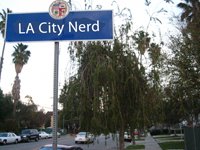
Did you know that synchronizing traffic lights on L.A. City streets really won't make much of a difference?
On Monday of this week, Mayor Villariagosa announced the completion of Signal synchronization project with the completion of an ATSAC project. According to the Daily News on Tuesday:
"NORTHRIDGE - Calling it an early Valentine's Day present, Mayor Antonio Villaraigosa on Monday announced the completion of the last major traffic-light synchronization project in the San Fernando Valley, expected to shave 15 percent off commute times along certain routes."
Sadly this information may be misleading.
First, this is not the completion of ATSAC in the Valley; a major portion still remains to be synchronized. The signals west of the 405 between Sherman Way & Devonshire are not part of this system. So, a large portion of the West Valley (not to mention the parts in the far Northwest Valley) are not digitally linked or being monitored.
Second, this major plan to synchronize traffic lights is a good thing to say, but most signals in the City are already in sync with each other and automated by the City's innovative ATSAC system. The traffic there is still not good. The mayor's promise to synchronize the City's traffic signals sounds good, but the streets already in sync are at capacity. So though the signals may be tuned to traffic at 37 miles per hour, the streets can't handle the volume.
So, don't be misled. It's nice to talk about synchronization, but the real issue in moving traffic is volume and capacity.


2 comments:
People don't drive all day, they have a destination. When they arrive, their car ceases to take up roadspace. Every car which you can get off the roadway one minute sooner, relieves congestion by one car-minute. Enough car-minutes freed up and you break up the log jam. Add a few back and gridlock returns.
In 1990 Nick Patsaouras of the RTD, and the LA Times, held a contest called "People Moving LA in the 90's" to get ideas to aid in traffic congestion planning. I was one of the winners, with my proposal for traffic light synchronization by means of a distributed parallel computer system, where each local light controller (processor) in the grid would not only survey and manage immediate local traffic in a very dynamic way, but each controller would also forward traffic information in real time to each of it's nearest contoller neighbors, so that each could anticipate traffic from further away, and add that to the algorithm for immediate processing. The control algorithms could get updated remotely as we learned how to make them smarter over time. Immediate local computing power simply has to be far superior to a slow centralized sync system.
Although I was presented with a nice plaque, and a couple nice little gifts at the luncheon, this idea was never given serious consideration because of the centralized system they were already adopting. 16 years later trafiic syncing is making the news, but like you say, keeping everyone at 37MPH just isn't going to fly.
I'm sure it's too late to reconsider, but I just wish someone with some influence would look into it.
box2000@pacbell.net
People don't drive all day, they have a destination. When they arrive, their car ceases to take up roadspace. Every car which you can get off the roadway one minute sooner, relieves congestion by one car-minute. Enough car-minutes freed up and you break up the log jam. Add a few back and gridlock returns.
In 1990 Nick Patsaouras of the RTD, and the LA Times, held a contest called "People Moving LA in the 90's" to get ideas to aid in traffic congestion planning. I was one of the winners, with my proposal for traffic light synchronization by means of a distributed parallel computer system, where each local light controller (processor) in the grid would not only survey and manage immediate local traffic in a very dynamic way, but each controller would also forward traffic information in real time to each of it's nearest contoller neighbors, so that each could anticipate traffic from further away, and add that to the algorithm for immediate processing. The control algorithms could get updated remotely as we learned how to make them smarter over time. Immediate local computing power simply has to be far superior to a slow centralized sync system.
Although I was presented with a nice plaque, and a couple nice little gifts at the luncheon, this idea was never given serious consideration because of the centralized system they were already adopting. 16 years later trafiic syncing is making the news, but like you say, keeping everyone at 37MPH just isn't going to fly.
I'm sure it's too late to reconsider, but I just wish someone with some influence would look into it.
box2000@pacbell.net
Post a Comment